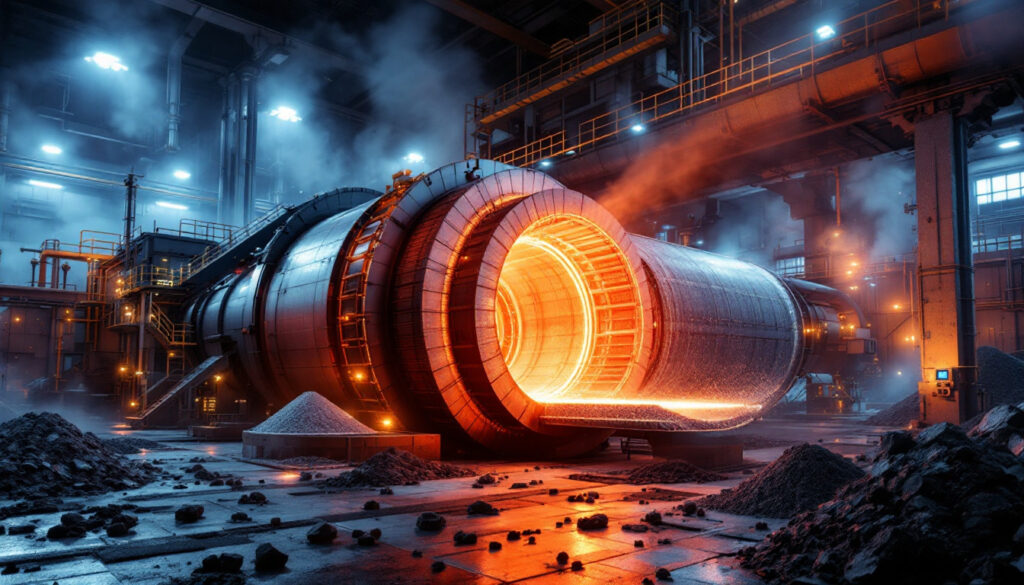What is a Calcining Kiln for Manganese Production?
A calcining kiln is a specialized thermal processing unit designed to convert manganese ore into manganese oxide through controlled heating. This crucial step removes moisture, carbonates, and other volatile components, preparing the ore for further processing into high-value manganese products.
The process fundamentally involves the decomposition of manganese carbonate (MnCO₃) into manganese oxide (MnO) and carbon dioxide (CO₂) at temperatures ranging from 800-1000°C. This transformation concentrates the manganese content, making it more suitable for downstream applications.
"Our kiln delivers energy savings crucial to the minerals processing industry—potentially transformative for the market." — Peter Allen, Managing Director of Firebird Metals
Recent advancements in mining industry innovation have dramatically improved efficiency. For instance, Firebird Metals' innovative kiln processed 3.3 tonnes of lower-grade manganese ore with energy consumption of only 230kW/t, significantly outperforming conventional kilns that typically require over 400kW/t.
How Does a Calcining Kiln Work in Manganese Processing?
The Basic Principles of Calcination
Calcination is a thermal treatment process that heats manganese ore to temperatures between 800-1000°C in a controlled environment. During this 1-3 hour process, volatile components are driven off, and chemical transformations occur.
The primary reaction converts manganese carbonate into manganese oxide:
MnCO₃ → MnO + CO₂
This decomposition concentrates the manganese content while removing carbon dioxide, creating a product with higher reactivity for leaching processes.
Types of Calcining Kilns for Manganese
Several kiln designs are employed in manganese processing, each with distinct advantages:
-
Rotary Kilns: Cylindrical vessels that rotate continuously while material passes through, providing excellent mixing but higher energy consumption.
-
Vertical Shaft Kilns: Stationary vessels where material moves downward by gravity, offering better energy efficiency and thermal control. Firebird's vertical shaft design has demonstrated up to 70% energy reduction for high-grade ores.
-
Fluidized Bed Kilns: Systems where gas flows upward through a bed of solid particles, creating uniform heating and rapid processing but requiring specific particle size ranges.
-
Energy-Efficient Kilns: Modern designs incorporating improved heat recovery systems, optimized combustion, and advanced refractory materials that significantly reduce energy requirements.
Key Process Parameters
The effectiveness of manganese calcination depends on several critical factors:
-
Temperature profile: Maintaining 800-1000°C throughout the kiln ensures complete decomposition without sintering.
-
Residence time: Material typically requires 1-3 hours of exposure, with the precise time dependent on ore characteristics.
-
Atmosphere control: Carefully managed oxygen levels prevent unwanted oxidation or reduction reactions.
-
Feed material characteristics: Particle size distribution and moisture content significantly impact heat transfer efficiency.
-
Energy input and distribution: Advanced kilns utilize precise thermal profiling to optimize energy usage, with Firebird's pilot kiln achieving remarkable efficiency at 80-100kWh/t for high-grade ore.
"Advanced automation enables real-time temperature control, critical for consistent product quality." — Industry best practice
What Are the Latest Innovations in Calcining Technology?
Energy-Efficient Kiln Designs
Recent technological breakthroughs have revolutionized energy efficiency in manganese calcination. Firebird Metals' innovative kiln design, currently under international patent application, has demonstrated energy consumption of only 230kW/t compared to conventional rotary kilns requiring over 400kW/t.
For higher-grade manganese ore (≥40% Mn), their pilot kiln operates at just 80-100kWh/t, potentially reducing energy usage by more than 70% at commercial scale. This translates to approximately $30/t in operational savings—a significant competitive advantage in an energy-intensive industry.
The key innovations include:
- Optimized heat transfer surfaces
- Multi-zone temperature control
- Advanced refractory materials with superior insulation properties
- Precise airflow management systems
Improved Process Control Systems
Modern calcining kilns incorporate sophisticated automation and data-driven operations:
-
Real-time temperature profile management: Distributed temperature sensors provide continuous data for automated adjustments.
-
Automated feed rate adjustment: AI-based systems optimize throughput based on ore characteristics and desired product specifications.
-
Predictive maintenance systems: Vibration analysis and thermal imaging detect potential failures before they occur, reducing downtime by up to 40%.
-
Emissions monitoring and control: Continuous gas analyzers ensure environmental compliance while optimizing combustion efficiency.
-
Digital twin modeling: Computer simulations optimize thermal profiles, reducing fuel use by approximately 15% according to Firebird's technical reports.
"Digital twin modeling optimizes thermal profiles, reducing fuel use by 15%." — Firebird technical report
Environmental Impact Reduction
New kiln designs focus on minimizing environmental footprint through:
-
Reduced carbon emissions: Lower energy consumption directly translates to fewer greenhouse gases, with CO₂ emissions reduced by approximately 0.5t per tonne of MnO produced.
-
Improved dust collection systems: Modern electrostatic precipitators and baghouses capture over 90% of particulate emissions.
-
Heat recovery for secondary processes: Waste heat exchangers capture thermal energy for preheating materials or generating electricity.
-
Alternative fuel compatibility: Flexible burner systems accommodate natural gas, hydrogen, or biofuels.
-
Reduced waste generation: Optimized processes minimize the production of off-spec material and secondary waste streams.
What Are the Benefits of Advanced Calcining for Manganese Production?
Economic Advantages
Modern calcining technology offers compelling economic benefits:
-
Energy cost reduction: Approximately $30/t savings (around 5% of production costs), with operating cost reductions of 43-80% compared to conventional technologies.
-
Increased throughput capacity: Advanced kilns process more material in less time, improving capital efficiency.
-
Improved product quality and consistency: Precise temperature control reduces variability, minimizing quality-related losses.
-
Reduced maintenance requirements: Modern designs experience 15-25% lower maintenance costs due to improved refractory life and simplified mechanical systems.
-
Extended equipment lifespan: Advanced materials and optimized operating conditions can extend kiln service life by 30-50%.
The capital costs for advanced kilns typically range from $1-5 million depending on capacity, with payback periods of 3-5 years based on operational savings.
Product Quality Improvements
Advanced calcining processes enhance manganese product characteristics:
-
Higher manganese recovery rates: Firebird's testing achieved approximately 95% leaching efficiency, significantly improving downstream yields.
-
Lower residual manganese: Post-leaching residue contained only approximately 1.5% manganese, reducing valuable metal losses.
-
More consistent particle size distribution: Uniform heating produces more homogeneous material properties.
-
Reduced impurity levels: Precise temperature control selectively volatilizes contaminants without affecting manganese content.
-
Improved reactivity: Optimized calcination creates an ideal crystal structure for subsequent chemical processing.
"Energy-efficient kilns position Firebird as a low-cost MnSO₄ producer." — Peter Allen
Versatility Across Applications
Modern calcining kilns offer remarkable flexibility:
-
Processing different manganese ore grades: From low-grade (20-30% Mn) to high-grade (>40% Mn) materials.
-
Adaptability to iron ore beneficiation: The same technology applies to iron carbonate processing.
-
Lithium sulfate production capability: Modified kilns can process lithium-bearing minerals.
-
Adjustable for various mineral processing requirements: Temperature profiles and residence times can be customized for specific ore characteristics.
This versatility allows mining operations to process diverse ore bodies economically, a critical advantage as high-grade deposits become scarcer.
How is Calcined Manganese Used in Different Industries?
Battery Manufacturing
Calcined manganese has become indispensable in battery production:
-
Essential for manganese sulfate (MnSO₄) production: Approximately 60% of MnSO₄ used in lithium-ion batteries originates from calcined manganese.
-
Key ingredient in LMFP (Lithium Manganese Iron Phosphate) cathodes: These next-generation batteries offer improved safety and lower cost compared to traditional lithium-ion formulations.
-
Used in alkaline battery formulations: MnO₂ derived from calcined materials powers billions of consumer batteries annually.
-
Component in emerging battery technologies: Manganese-rich cathodes are being developed for sodium-ion and solid-state batteries.
"LMFP cathodes require high-purity MnO to ensure battery longevity." — Battery industry report
Steel Production
The steel industry relies heavily on calcined manganese, consuming approximately 90% of global manganese for:
-
Deoxidizing agent: Manganese scavenges oxygen during steelmaking, preventing porosity and improving mechanical properties.
-
Alloying element: Adding 0.2-1.5% manganese increases strength, hardness, and wear resistance in carbon steels.
-
Sulfur neutralization: Manganese binds with sulfur impurities to prevent hot shortness (brittleness at high temperatures).
-
Component in specialty steel formulations: High-manganese steels (12-14% Mn) exhibit exceptional work-hardening properties for high-impact applications.
Chemical Manufacturing
Calcined manganese serves as a precursor for various chemical products:
-
Catalyst production: MnO₂ catalysts accelerate organic synthesis reactions and environmental remediation processes.
-
Pigment manufacturing: Manganese compounds create distinctive brown, black, and purple colorants for ceramics, glass, and paints.
-
Agricultural supplements: Manganese micronutrients enhance crop yields and disease resistance.
-
Water treatment chemicals: Manganese compounds remove heavy metals and organic contaminants from drinking water and industrial effluents.
What Factors Affect Calcining Kiln Efficiency?
Raw Material Characteristics
The properties of manganese ore significantly impact calcination efficiency:
-
Ore grade: Higher-grade materials (≥40% Mn) process more efficiently, requiring as little as 80kWh/t in advanced kilns compared to 230kWh/t for lower-grade ores.
-
Mineral composition: Carbonate-rich ores require more energy due to the endothermic decomposition reaction, while oxide ores need less thermal input.
-
Moisture content: Materials with >5% moisture content increase energy requirements by approximately 20% due to the latent heat of water vaporization.
-
Particle size distribution: Optimized size ranges (typically 5-20mm) ensure efficient heat transfer without excessive dust generation or airflow restriction.
-
Impurity profile: Certain elements (e.g., silica, alumina) affect heat transfer and can damage refractory linings if present in high concentrations.
Operational Parameters
Optimizing operational conditions is crucial for efficient calcination:
-
Temperature control precision: Maintaining ±10°C temperature tolerance throughout the kiln prevents energy waste and product quality issues.
-
Feed rate consistency: Uniform material flow prevents hotspots and ensures complete processing.
-
Residence time management: Adjusting material throughput to match the required thermal exposure time maximizes throughput without compromising quality.
-
Combustion efficiency: Advanced burner systems with optimized air-to-fuel ratios minimize wasted energy.
-
Heat recovery implementation: Capturing waste heat from exhaust gases can reduce primary energy requirements by 15-25%.
"Particle size distribution directly impacts heat transfer rates." — Process engineering guidelines
Maintenance Practices
Proper maintenance ensures sustained kiln performance:
-
Regular refractory inspection and replacement: Damaged linings increase heat loss and energy consumption.
-
Drive system maintenance: Lubrication and component monitoring prevent costly failures and downtime.
-
Seal integrity verification: Minimizing air infiltration prevents heat loss and maintains atmosphere control.
-
Burner system optimization: Regular tuning ensures efficient combustion and temperature profile.
-
Instrumentation calibration: Accurate temperature and flow measurements are essential for process optimization.
What Are the Economic Considerations for Manganese Calcining Operations?
Capital Investment Requirements
Establishing a manganese calcining operation involves significant investment:
-
Kiln equipment: Typically $1-5 million depending on capacity and technology level.
-
Material handling systems: Conveyors, bins, and feeders add 15-25% to base kiln cost.
-
Emissions control equipment: Dust collection and gas treatment systems represent 10-20% of capital expenditure.
-
Utilities infrastructure: Power distribution, gas supply, and water systems add another 5-15% to project costs.
-
Automation and control systems: Modern distributed control systems represent 8-12% of total investment but provide substantial operational benefits.
"Scalability of Firebird's kiln design minimizes CAPEX for mid-tier miners." — Financial analyst report
Operating Cost Analysis
Understanding operating costs is essential for profitability:
| Cost Component | Conventional Kiln | Energy-Efficient Kiln | Potential Savings |
|---|---|---|---|
| Energy | 400+ kWh/t | 80-230 kWh/t | 43-80% |
| Maintenance | Higher | Lower | 15-25% |
| Labor | Higher | Lower (automation) | 10-20% |
| Environmental | Higher | Lower | Variable |
These savings can improve profit margins significantly, particularly in regions with high energy costs. For a typical operation producing 50,000 tonnes annually, energy savings alone could exceed $1.5 million per year.
Return on Investment Factors
Several factors influence ROI for calcining kiln for manganese production:
-
Energy price volatility: Regions with high or fluctuating energy costs see faster payback from efficient kilns.
-
Product market conditions: Strong demand for high-quality MnO or MnSO₄ improves price premiums for superior products.
-
Regulatory compliance requirements: Stricter emissions standards favor advanced technologies despite higher initial costs.
-
Technology scalability: Modular designs allow capacity expansion as market demands grow.
-
Operational efficiency improvements: Reduced downtime and maintenance translate to higher annual throughput from the same capital asset.
The typical payback period for advanced calcining technology ranges from 3-5 years, depending on these factors. Operations in high-energy-cost regions or producing premium products may see ROI in as little as 2 years.
How Are Calcining Kilns Being Used in Commercial Manganese Production?
Case Study: Firebird Metals and Taza Metal Technologies
Firebird Metals recently completed calcining and leaching test work for Taza Metal Technologies, a Kazakhstan-based manganese mining and chemical processing company. The test processed 3.3 tonnes of lower-grade manganese ore from Taza's Kazakhstan mine, achieving:
- Energy consumption of only 230kW/t (compared to 400kW/t for conventional kilns)
- Approximately 95% manganese leaching rate
- Residual manganese content of approximately 1.5% in acid leaching residue
This collaboration demonstrates both the commercial viability and industry demand for energy-efficient calcining technology in manganese processing. The successful test results have positioned Firebird's technology for potential commercial deployment in Taza's operations.
Global Implementation Trends
Calcining technology adoption varies worldwide:
-
China: Leading in innovative kiln development, accounting for approximately 65% of global manganese processing. Chinese manufacturers are focusing on automation and emissions reduction.
-
Australia: Focusing on energy-efficient designs like Firebird's vertical shaft kiln. Australian innovations emphasize modular, scalable systems suitable for remote operations.
-
Kazakhstan: Exploring advanced processing methods through partnerships like the Taza-Firebird collaboration. The country aims to move up the value chain from ore export to processed products.
-
South Africa: Upgrading traditional calcining operations with heat recovery systems and improved controls. South African operations typically process higher-grade ores allowing for optimized energy consumption.
-
Brazil: Investing in integrated manganese processing facilities that combine mining, calcining, and chemical production. Brazilian producers emphasize vertical integration to capture more value.
"South Africa's traditional kilns are being retrofitted with heat recovery systems." — Industry report
The global trend clearly points toward more energy-efficient, environmentally sound calcining technologies as energy costs rise and environmental regulations tighten.
What Environmental Considerations Apply to Manganese Calcining?
Emissions Management
Modern calcining operations must address several emission types:
-
Particulate matter: Dust control systems (baghouses, electrostatic precipitators) capture over 90% of airborne particles, preventing worker exposure and environmental contamination.
-
Carbon dioxide: Releases occur from both fuel combustion and carbonate decomposition, totaling approximately 0.5t CO₂ per tonne of MnO produce
Want to Capitalise on the Next Mineral Discovery?
Discover the market advantage of real-time alerts for significant ASX mineral discoveries, powered by Discovery Alert's proprietary Discovery IQ model, translating complex mineral data into actionable insights. Explore why major mineral discoveries can lead to significant market returns by visiting Discovery Alert's dedicated discoveries page, showcasing historic examples of exceptional outcomes.




